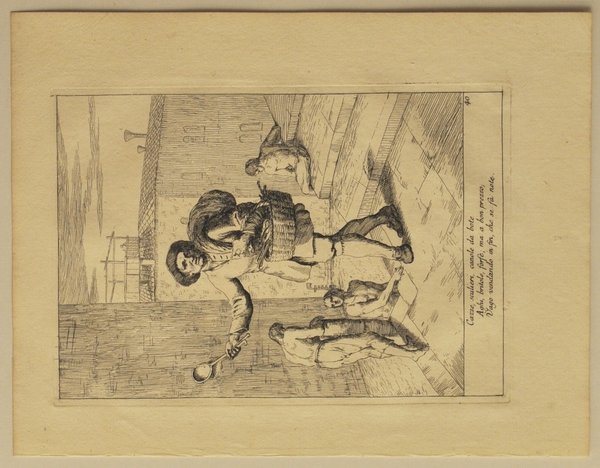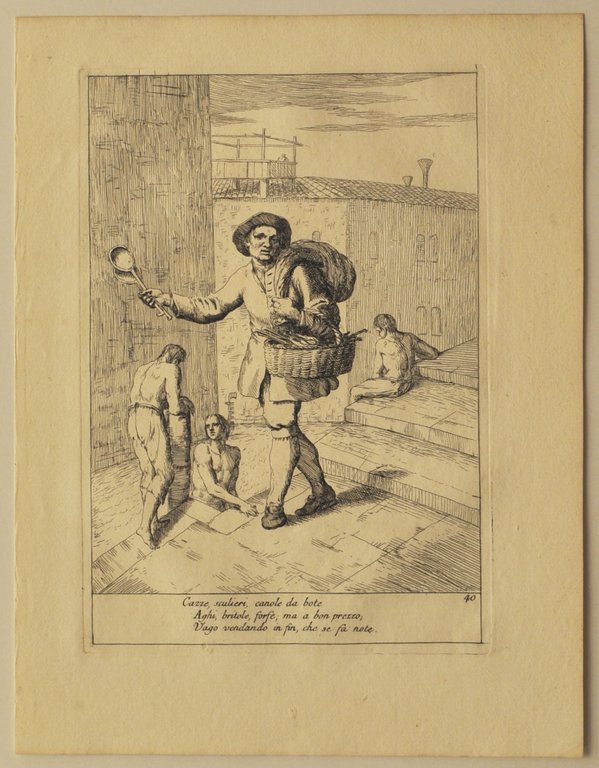Acquaforte e bulino di mm 261 x 182. II/VI. Vergata veneziana tre lune, filigrana tre lune e scritta imperial. Bel foglio a pieni margini. Perfetta condizione. "Cazze, sculieri, canole da bote Aghi, britole, forfe; ma a bon prezzo; Vago vendando in fin, che se fa note". A destra in basso numero 40. Proveniente da "Le Arti che vanno per via nella Città di Venezia inventate ed incise da Gaetano Zompini. Aggiuntavi una memoria di detto autore" Venezia 1785. Magnifica incisione in acquaforte e bulino della serie delle "Arti che van per via" di Zompini, stampata in una rarissima prima edizione coeva nel 1753, ed in questo secondo stato nel 1785 dal residente britannico John Strange. Venne ripubblicato in Inghilterra altre quattro volte. Da una lettera di John Strange si viene a sapere che la tiratura della presente edizione era di cento o duecento copie. Dario Succi "Da Carlevarijs a Tiepolo, Incisori veneti e friulani del settecento" pag. 454. "Gaetano Zompini nacque a Narvesa il 29 settembre 1698; fu mandato a Venezia nella Scuola del Cavalier Bambini in que' tempi riputatissimo. Apprese dal suddetto oltre li principi del buon dissegno, anche in gran parte il suo modo di dipingere, ed uscito poi di detta Scuola si diede anche ad imitare la maniera di Sebastiano Ricci.Inventò pure e disegnò per il sig. Zatta stampatore in Venezia buona parte delle Figure per le Edizioni del Dante e del Petrarca da lui stampata. Questo degno Pittore visse però quasi sempre povero, avendo numerosa Famiglia. Antonio Maria Zanetti, lo tirò appresso di sé, impiegandolo in vari lavori e lavorò in gran parte sopra alcuni rami tratti da' disegni di Gio. Benedetto Castiglione. Quindi diede alle stampe una Raccolta delle Arti di Venezia, che vanno per via. &0 rami rappresentanti l'Arti suddette, a imitazione delle Arti di Bologna similmente inventate ed incise da Annibale Carracci. A quest'opera fatta all'acqua forte, della quale alcune copie furono anche miniate, aggiunse sotto ogni rame alcuni versi il Dottor Questini Prete di Santa Maria Mater Domini, amico dello Zompini. Mancò di vivere il 20 Maggio 1778 nell'avanzata età di 76 anni." (EN) Etching and burin, 261 x 182 mm. II/VI. Venetian laid paper with three moons, three moon watermark and imperial writing. Beautiful sheet with full margins. Perfect condition. "Cazze, sculieri, canole da bote Aghi, britole, forfe; ma a bon prezzo; Vago vendando in fin, che se fa note". Number 40 at the bottom right. From "The Arts that go by way in the City of Venice invented and engraved by Gaetano Zompini. Added a memoir by the said author" Venice 1785. Magnificent etching and burin from the series of the "Arts that go by way" by Zompini, printed in a very rare first contemporary edition in 1753, and in this second state in 1785 by the British resident John Strange. It was republished in England four more times. From a letter by John Strange we learn that the print run of the present edition was one or two hundred copies. Dario Succi "From Carlevarijs to Tiepolo, Venetian and Friulian Engravers of the Eighteenth Century" pag. 454. "Gaetano Zompini was born in Narvesa on September 29, 1698; he was sent to Venice to the School of the Cavalier Bambini, which was highly regarded at the time. He learned from the aforementioned, in addition to the principles of good design, also a large part of his way of painting, and after leaving the said School he also began to imitate the manner of Sebastiano Ricci. He also invented and designed for Mr. Zatta, a printer in Venice, a good part of the Figures for the Editions of Dante and Petrarca that he printed. This worthy Painter, however, lived almost always in poverty, having a large family. Antonio Maria Zanetti, took him with him, employing him in various works and worked largely on some copper plates taken from the drawings of Gio. Benedetto Castiglione. Then he published a Collection of the Arts of Venice, which are on the road. &0 copper plates representing the aforementioned Arts, in imitation of the Arts of Bologna similarly invented and engraved by Annibale Carracci. For this work he made Doctor Questini, Priest of Santa Maria Mater Domini, a friend of Zompini, added some verses under each copperplate to the etching, some copies of which were also illuminated. He passed away on May 20, 1778 at the advanced age of 76."


Descubre cómo utilizar
Descubre cómo utilizar

